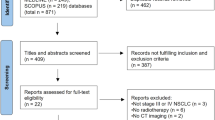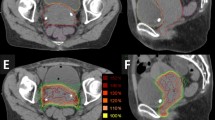Abstract
Introduction
A survey regarding radiobiological questions in the treatment of lung cancer (LC) was done to study the clinical aspects of radiotherapy in Spain, in order to standardise treatment decisions.
Methods and materials
From November 2007 to March 2008, a survey was performed among radiation oncologists in Spain specialising in LC treatment via e-mail, which included questions regarding different radiobiological aspects of radiotherapy LC treatment. The extent of the resulting material made it necessary to divide it into two parts; the first is presented in this article. The second, which includes items about α/β-NTCP/TCP values and reirradiation criteria, will be reported elsewhere.
Results
Thirty-one radiation therapists from 29 radiation oncology departments answered the survey. 77.4–93.5% of responders used the basic formula from the linear-quadratic model and/or computer software for radiobiological calculations; 100% used lung (mostly V20, median <30%) and spinal cord constraints (mostly a median of physical maximum dose <45.5 Gy); and 90.3% used heart and oesophagus constraints (very heterogeneous parameters in both organs).
Conclusions
Radiobiological considerations are clearly present in the planning process of radiotherapy of LC in Spain, with a high coincidence with the literature regarding lung and spinal cord constraints. The heterogeneity shown for oesophagus and heart results demonstrates the need for continuing investigation into the standardisation of clinical, dosimetric and radiobiologic aspects of the treatment of this cancer.
Similar content being viewed by others
References
Casas F, Viñolas N, Sanchez-Reyes A et al (2006) Spanish patterns of care for 3D radiotherapy in non-small lung cancer. Int J Radiat Oncol Biol Phys 65:138–142
Casas F, SEOR WORKING GROUP (2007) Foundation of the“Grupo Oncológico para el estudio del Cáncer de Pulmón” (GOECP/SEOR). Clin Transl Oncol 9:345–346
Emami B, Lyman J, Brouwn A et al (1991) Tolerance of normal tissue to therapeutic irradiation. Int J Radiat Oncol Biol Phys 21:109–122
Willner J, Jost A, Baier K, Flentje M (2003) A little to lot or a lot a little? An analysis of pneumonitis risk from dose-volume histogram parameters of the lung in patients with lung cancer treated with 3-D conformal radiotherapy. Strahlenther Onkol 179:548–556
Graham MV, Purdy JA, Emami B et al (1998) Clinical dose-volume histogram analysis for pneumonitis after 3D treatment for non-small cell lung cancer (NSCLC). Int J Radiat Oncol Biol Phys 45:323–329
Tsujino K, Hirota S, Endo M et al (2003) Predictive value of dose-volume histogram parameters for predicting radiation pneumonitis after concurrent chemoradiation for lung cancer. Int J Radiat Oncol Biol Phys 55:110–115
Bradley J, Graham MV, Winter K et al (2005) Toxicity and outcome results of RTOG 9311: a phase I-II dose-escalation study using three-dimensional conformal radiotherapy in patients with inoperable non-small-cell lung carcinoma. Int J Radiat Oncol Biol Phys 61:318–328
Armstrong JG, Raben A, Zelefsky M et al (1997) Promising survival with three-dimensional conformal radiation therapy for non-small cell lung cancer. Radiother Oncol 44:17–22
Hernando ML, Marks LB, Bentel GC et al (2001) Radiation induced pulmonary toxicity: a dose-volume histogram analysis in 201 patients with lung cancer. Int J Radiat Oncol Biol Phys 51:650–659
Lee HK, Vaporciyan AA, Cox JD et al (2003) Postoperative pulmonary complications alter preoperative chemoradiation for esophageal carcinoma: correlation with pulmonary dose-volume histogram parameters. Int J Radiat Oncol Biol Phys 57:1317–1322
Wang S, Liao Z, Wei X et al (2006) Analysis of clinical and dosimetric factors associated with treatment-related pneumonitis (TRP) in patients with non-small cell lung cancer (NSCLC) treated with concurrent chemoradiotherapy and three-dimensional conformal radiotherapy (3D-CRT). Int J Radiat Oncol Biol Phys 66:1399–1407
Gopal R, Tucker SL, Komaki R et al (2003) Dosevolume histogram analysis as predictor of radiation pneumonitis in primary lung cancer patients treated with radiotherapy. Int J Radiat Oncol Biol Phys 56:106–113
Seppenwoolde Y, Lebesque12 JV, de Jaeger K et al (2003) Comparing different NTCP models that predict the incidence of radiation pneumonitis. Int J Radiat Oncol Biol Phys 55:724–735
Rodrigues G, Lock M, D’souza D et al (2004) Prediction of radiation pneumonitis by dose-volume histogram parameters in lung cancer: a systematic review. Radiother Oncol 71:127–138
Kim TH, Cho KH, Pyo HR et al (2005) Dosevolumetric parameters for predicting severe radiation pneumonitis after three-dimensional conformal radiation therapy for lung cancer. Radiology 235:208–215
Kong FM, Hayman JA, Griffith KA et al (2006) Final toxicity results of a radiation-dose escalation study in patients with non-small-cell lung cancer (NSCLC): predictors for radiation pneumonitis and fibrosis. Int J Radiat Oncol Biol Phys 65:1075–1086
Ball D, Bishop J, Smith J et al (1995) A phase III study of accelerated radiotherapy with and without carboplatin in non-small cell lung cancer: an interim toxicity analysis of the first 100 patients. Int J Radiat Oncol Biol Phys 31:267–272
Choy H, LaPorte K, Knill-Selby E et al (1999) Esophagitis in combined modality therapy for locally advanced non-small cell lung cancer. Semin Radiat Oncol 9[Suppl 1]:90–96
Yuan S, Sun X, Li M et al (2007) A randomized study of involved-field irradiation versus elective nodal irradiation in combination with concurrent chemotherapy for inoperable stage III non small cell lung cancer. Am J Clin Oncol 30:239–244
Hirota S, Tsujino K, Endo M et al (2001) Dosimetric predictors of radiation esophagitis in patients treated for non-small-cell lung cancer with carboplatin/paclitaxel/radiotherapy. Int J Radiat Oncol Biol Phys 51:291–295
Bradley J, Deasy JO, Bentzen S, El-Naqa I (2004) Dosimetric correlates for acute esophagitis in patients treated with radiotherapy for lung carcinoma. Int J Radiat Oncol Biol Phys 58:1106–1113
Kim TH, Cho KH, Pyo HR et al (2005) Dosevolumetric parameters of acute esophageal toxicity in patients with lung cancer treated with three-dimensional conformal radiotherapy. Int J Radiat Oncol Biol Phys 62:995–1002
Maguire PD, Sibley GS, Zhou SM et al (1999) Clinical and dosimetric predictors of radiation-induced esophageal toxicity. Int J Radiat Oncol Biol Phys 45:97–103
Takeda K, Remoto K, Saito H et al (2005) Dosimetric correlations of acute esophagitis in lung cancer patients treated with radiotherapy. Int J Radiat Oncol Biol Phys 62:626–629
Wei X, Liu H, Tucker S et al (2006) Risk factors for acute esophagitis in non-small-cell lung cancer patients treated with concurrent chemotherapy and three-dimensional conformal radiotherapy. Int J Radiat Oncol Biol Phys 66:100–107
Algara M, Rodríguez N, Viñals P et al (2007) Prevention of radiochemotherapy-induced esophagitis with glutamine. A pilot study. Int J Radiat Oncol Biol Phys 69:342–349
Rodríguez N, Algara M, Foro P et al (2009) Predictors of acute esophagitis in lung cancer patients treated with concurrent three-dimensional conformal radiotherapy (3D-CRT) and chemotherapy. Int J Radiat Oncol Biol Phys 73:810–817
Singh AK, Lockett MA, Bradley JD (2003) Predictors of radiation-induced esophageal toxicity in patients in patients with non-small cell lung cancer treated with three-dimensional conformal radiation therapy. Int J Radiat Oncol Biol Phys 55:337–341
Ahn S, Kahn D, Zhou S et al (2005) Dosimetric and clinical predictors for radiation-induced esophageal injury. Int J Radiat Oncol Biol Phys 61:335–347
Boden G (1948) Radiation myelitis of the cervical spinal cord. Br J Radiol 21:464–469
Schultheiss TE, Kun LE, Ang KK, Stephens LC (1995) Radiation response of the central nervous system. Int J Radiat Oncol Biol Phys 31:1093–1112
Fowler JF (1989) The linear-quadratic formula and progress in fractionated radiotherapy. Br J Radiol 62:679–694
Martel MK, Sahijdak WM, Ten Haken RK et al (1998) Fraction size and dose parameters related to the incidence of pericardial effusions. Int J Radiat Oncol Biol Phys 40:155–161
Kong FM, Pan C, Eisbruch A, Ten Haken RK (2007) Physical models and simpler dosimetric descriptors of radiation late toxicity. Semin Radiat Oncol 17:108–120
Sandri MT, Cardinale D, Zorzino L et al (2003) Minor increases in plasma troponin I predict decreased left ventricular ejection fraction after high-dose chemotherapy. Clin Chem 49:248–252
Pignon JP, Tribodet H, Scagliotti GV et al (2008) Lung adjuvant cisplatin evaluation: a pooled analysis by the LACE Collaborative group. J Clin Oncol 26:3552–3559
Author information
Authors and Affiliations
Consortia
Corresponding author
Rights and permissions
About this article
Cite this article
González, J.A., Chust, M., Delgado, R. et al. Spanish radiobiological pattern of care in lung cancer: a GOECP/SEOR study. Clin Transl Oncol 12, 292–298 (2010). https://doi.org/10.1007/s12094-010-0506-8
Received:
Accepted:
Published:
Issue Date:
DOI: https://doi.org/10.1007/s12094-010-0506-8




